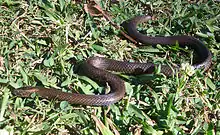Golden-crowned snake
The golden-crowned snake (Cacophis squamulosus)[4] is a small species of venomous snake in the family Elapidae. The species is endemic to Australia.
| Golden-crowned snake | |
|---|---|
 | |
| Scientific classification | |
| Domain: | Eukaryota |
| Kingdom: | Animalia |
| Phylum: | Chordata |
| Class: | Reptilia |
| Order: | Squamata |
| Suborder: | Serpentes |
| Family: | Elapidae |
| Genus: | Cacophis |
| Species: | C. squamulosus |
| Binomial name | |
| Cacophis squamulosus | |
| Synonyms[3] | |
Habitat
Like other Cacophis species, the golden-crowned snake is a forest specialist, particularly rainforest. It prefers deeper forested areas, particularly rainforest on mountain slopes, however it can show up in suburbs near waterways and moist environments with ground cover and shelter.[5]
Venom
Cacophis squamulosus is only mildly venomous; however, it will bluff and mock bite if threatened, rearing into an S-shape to display the bright orange ventral pigmentation. Bites from larger individuals may present a health risk; however, it is more likely to attempt to intimidate those it feels threatened by.
Diet
The diet of the golden-crowned snake consists mostly of skinks and other small lizards which they hunt at night; they may also take frogs and tadpoles.
Geographic range
Cacophis squamulosus is localised to eastern Australia, from Canberra, ACT, to Cairns, QLD.[5]
Description
The average total length (including tail) of C. squamulosus is 50 cm (20 in), but it may reach 98 cm (39 in), making it the largest of the crowned snakes. The golden-crowned snake has a dorsal surface grayish-brown to dark brown in colour, and a ventral surface of orange to pink, with a mid-line of black spots. The "crown" is a pale yellow-brown stripe starting at the snout and sweeping back along both sides of the head, not connecting at the back of the head as in C. krefftii or C. harriettae, instead trailing down the neck. The Dorsal scales are in 15 rows at mid-body.[5]
References
- Shea, G.; Wilson, S.; Hobson, R.; Venz, M.; Vanderduys, E. (2018). "Cacophis squamulosus". IUCN Red List of Threatened Species. 2018: e.T102707094A102707128. doi:10.2305/IUCN.UK.2018-1.RLTS.T102707094A102707128.en. Retrieved 19 November 2021.
- "Cacophis squamulosus (Duméril, Bibron & Duméril, 1854)". Global Biodiversity Information Facility. Archived from the original on 28 July 2014. Retrieved 20 July 2014.
- "Cacophis squamulosus ". The Reptile Database. www.reptile-database.org.
- "Cacophis squamulosus (Duméril, Bibron & Duméril, 1854) - Golden-crowned Snake". Atlas of Living Australia. Retrieved 20 July 2014.
- Wilson, Steve; Swan, Gerry (2013). A Complete Guide to Reptiles of Australia, Fourth Edition. (2013). Sydney: New Holland Publishers. 522 pp. ISBN 9781921517280.
Further reading
- Cogger HG (2014). Reptiles and Amphibians of Australia, Seventh Edition. Clayton, Victoria, Australia: CSIRO Publishing. xxx + 1,033 pp. ISBN 978-0643100350.
- Duméril A-M-C, Bibron G, Duméril A [-H-A] (1854). Erpétologie générale ou histoire naturelle complète des reptiles. Tome septième. Deuxième partie. Comprenant l'histoire des serpents venimeux.
[= General Herpetology or the Complete Natural History of Reptiles. Volume 7. Part 2. Containing the Natural History of the Venomous Snakes]. Paris: Roret. xii + pp. 781-1536. (Pseudelaps squamulosus, new species, pp. 1235-1236). (in French).
